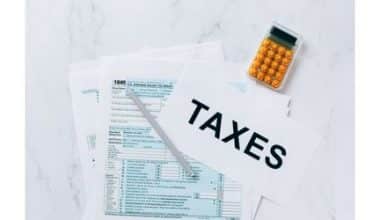If you’re looking for an easy way to figure out your Illinois state income tax rate, this guide will show you how. We’ll review Illinois income and sales tax rate history, the different brackets and their rates, along with some extra information like add-ons and deductions that can impact your tax bill. We’ll also discuss whether or not payroll taxes will increase in 2022 as they did last year (and what they did).
What is the Illinois State Income Tax Rate?
If you’re wondering what the Illinois State Income Tax Rate is, we’ve got your back! Here are some important things to know about the state’s tax system:
The income tax rate in Illinois is 3.75% to 4.95%.
Federal taxes can add up to another 14%. This means that if you make $100,000 per year, your total federal and state taxes may total as much as 44%.
Combined federal + state rates range from 13% – 43%. That’s a lot!
The Illinois Individual Income Tax Rate for 2019
- The Illinois individual income tax rate for 2019 is 3.75%.
- The Illinois individual income tax rate for 2020 is 4.95%.
- The Illinois individual income tax rate for 2021 is 4.95%.
- The Illinois individual income tax rate for 2022 is 4.95%.
- The Illinois individual income tax rate for 2023 is 4.95%.
How the Illinois State Income Tax Works
Illinois is a no-income-tax state. In fact, it’s one of three states that doesn’t levy an income tax on residents (the others are Alaska and Florida).
Illinois’ local sales and property taxes are levied at different rates than the state’s income tax. For example, The Cook County local income tax rate is 2 percent; Cook County property taxes can range from 0.25 mill per $100 assessed value to 1 mill per $100 assessed value; and Cook County sales taxes vary depending on location but average between 6 cents per gallon for gasoline and up to 10 cents per gallon for diesel fuel.
To learn more about how this differs from other states’ systems, read on!
What is My Illinois State Tax Bracket?
The Illinois state tax brackets are:
- Single filers with taxable income of $19,000 or less will pay a 5% rate.
- Married joint filers with taxable incomes of $37,000 or less will pay a 5% rate.
- Married filing separately filers with taxable incomes between $9,750 and $37,000 will be taxed at 10%.
- Heads of households whose combined income are over $85k but under 200k can expect to pay 12%; those who make more than 200k are subject to 22%.
How Do I File My Illinois State Taxes?
Online filing is the easiest way to file your Illinois state taxes. You can also file your Illinois state taxes by mail or in person at an Illinois tax office.
It is possible to file your return electronically via e-file and use online payment through the MyTax program. You must have Internet access and a tax identification number (ITIN) to use this payment method, but it is fast, easy, and convenient!
If you prefer paper filing or have questions about how to complete the process, please visit www.illinoistaxes.com for more information on what options are available to you depending on where you live or work outside of Chicago city limits
Am I Required to File an Illinois State Income Tax Return?
If you live in Illinois and are required to file a state income tax return, you must file an Illinois Form IT-1040.
If you lived in another state during the year, such as California or Florida, but have filed an income tax return with your home state (such as Florida), there may still be some additional requirements for filing an Illinois income tax return.
However, if a nonresident taxpayer is required to file an Illinois Form IT-1040 because they lived in Illinois during some part of the calendar year 2019 (even if just for one day), then they will not need any special information on this form other than what would be asked on any other Form 1040NR form: Social Security Numbers and Dependents’ Names(s).
What Are Illinois Additions, Subtractions, and Deductions?
Additions are tax credits you can claim on your taxes. Subtractions are expenses you can deduct from your income. And deductions are expenses that reduce your taxable income.
#1. Additions:
Illinois has several add-on programs, including the Earned Income Credit (EIC), Child Care Credit, and Credit for Tax Paid to Other States or Territories. The EIC provides partial assistance in reducing federal income taxes for low-income residents who qualify under certain circumstances; it’s worth an additional $1,000 per eligible child ($2,400 for a family).
The Child Care Credit allows parents who pay child care expenses for a child under age 13 or 19 with disabilities to claim 50% of such costs as a qualifying credit against their Illinois state tax liability.
#2. Subtractions:
You may be able to subtract certain medical or dental insurance premiums from taxable wages; qualified tuition reductions; contributions to IRAs and 401(k) plans made by employers on behalf of employees; employer-provided group term life insurance coverage provided during employment periods; worker’s compensation payments made by employers if they were due as compensation for bodily injury sustained during employment periods.*
#3. Deductions:
Personal exemptions allow taxpayers to reduce their taxable incomes by $4K ($5K married filing jointly) each year based on their circumstances (for example, a single person living alone qualifies for the full amount while a married couple qualifies for half the amount). Wages over $200K/$250K/$300K possibly subject them to depend upon other factors such as marital status
The Illinois State Tax Rate is Not Much Different From Other States
The Illinois state tax rate is not much different from other states. The highest marginal rate in Illinois is 4.95%. Other states have much higher state tax rates than Illinois, but the average marginal rate for all states is about 5%.
In 2020, the Illinois State Income Tax will be 4.95% on your first $65,000 of taxable income and 7% on your next $1 million of taxable income or more (up to a maximum total tax liability of 10%). If you don’t owe any federal tax (because you’re earning so little), this could be an advantage for some people because their local property taxes will also go down!
What is the Illinois State Income Tax Rate for 2020?
Illinois has an income tax rate of 3.75% to 4.95%. The highest marginal rate in the state is 4.95%, but there are many other states with higher taxes than that:
California: 6%
Maryland: 5%
New Jersey: 6% (3%)
Virginia: 5%
How Do You File Your IL State Income Taxes?
You can file your IL state income taxes online, by mail, or in person at a tax office.
Online:
The Illinois Department of Revenue offers two online services for filing your state return: Fast file and TaxACT. Both services are free to use and allow you to file both federal and state returns at the same time (plus they have other great features).
By Mail:
To mail in your federal return, you must complete Form 4506 and include any schedules that apply to you; also include all required attachments such as W-2 forms from employers with which you owe self-employment tax (SEIT), 1099s from banks/financial institutions where interest income was earned during the year, etc., bank deposits, etc., checking account statements showing total deposits into account each month since January 1st until present date along with check stubs showing withdrawals made each month since January 1st until present date along with canceled checks used as proof of payment received through debit card or direct deposit funds received through payroll deduction accounts
What Are the Income Tax Brackets in Il?
Illinois has nine tax brackets, but the state has one of the lowest rates in the country. The top marginal rate is 4.95%, which applies to taxable income over $2 million. For married taxpayers filing jointly, their first $12,700 taxable income is taxed at a flat 3.75%.
The second highest marginal rate—combined federal and state taxes—is 5% for all individuals making more than $500K/year ($200K for single filers). At this level of combined federal/state taxes on income above $500K/year (or even just above $200K), your total state and local line item should be at least half of what you make to avoid paying any additional taxes separately from your federal return
What Are the Property Tax Rates in Illinois?
Illinois has two property tax rates: a statewide tax rate based on the total value of all residential properties in the state and an optional countywide tax rate.
The property tax is assessed by counties and collected by local governments through their millage rate (or “tax millage”). This represents how much money each homeowner pays in yearly taxes. For example: If a property’s taxable value were $100,000 with a millage rate of 100 mills per $1,000 assessed valuation ($10), then that homeowner would pay $10 per month (or 10% of their total assessed value) toward local government coffers.
To determine how much your house costs to maintain over time—since it requires upkeep as well as repairs—you should take note of its current market value when purchasing or selling real estate assets such as homes or commercial properties because these factors affect what kind.
Illinois State Income Tax Rates vs. Other States.
Illinois has a state income tax of 3.75% to 4.95%. In comparison, other states have lower taxes on the same amount of income and sales tax rates that are lower than Illinois’ sales tax rate; some states don’t have any personal or corporate income taxes at all!
The flat rate is 3.75% in Illinois (the highest in America), with no deductions or credits allowed for items like medical expenses or donations to charity—this means that if you earn $100k per year, your full taxable amount will be $93k ($97k after federal contributions). If you make less money than this threshold, then it’s only taxed at 1%.
However, there are some exceptions: corporations pay 9% on long-term capital gains (profits) instead of 0%, which makes sense considering how much more capitalistic our country had become since 2008 when we first took office after President Obama won reelection against Mitt Romney despite having spent nearly half his tenure somewhere else before coming back home again just months later so he could run again as POTUS after losing ground during 2012 elections due for whatever reason(s).
Illinois State Income Tax Rate 2021
Illinois has a state income tax of 3.75% to 4.95%.
If you are single, your taxable income is $12,000 or less ($24,000 if married and filing jointly). The following factors will determine your actual Illinois State Income Tax Rate:
- Your filing status (single or head of household)
- The value on which you claim a personal exemption for yourself and any qualifying individuals related to you
Illinois Income Tax Rate History.
If you want to understand the Illinois income tax rate history or need a quick refresher on your state’s tax laws and rules, this guide can help.
The highest marginal rate in Illinois is 4.95%.
The highest marginal rate in Illinois is 4.95%. The average tax rate is 3.75%, which means that the median income-tax bill for a taxpayer with no exemptions or deductions will be $3,750 (or 3.75%) of their total income earned from all sources, including wages and salaries, interest, dividends, and capital gains/losses on investments held within this state during a calendar year starting January 1st until December 31st of the same year.
The lowest marginal rate in Illinois is 3.25%
Illinois has a state income tax of 3.75% to 4.95%. Some residents may overpay because Illinois is one of the few states with no federal tax deductions or credits.
The state adds a sales tax to its 5% flat rate, bringing the total taxable value to 10.25%. If you’re looking for a low cost of living and quality education and health care without high property taxes or other costs associated with living in Illinois (such as higher utility bills), it might be worth moving out west, where housing prices are lower and there are fewer income taxes than in most other areas of America’s largest economy.
Illinois Sales Tax Rate
Illinois is one of the few states that has no state sales tax. However, it does have a 6.25% rate on most items sold in the state. This means that if you buy something from an Illinois business, there will be a 6.25% combined sales tax added to your purchase price as well as any applicable local taxes (1-1.75%).
The average local sales tax rate for all 50 states is 1%. The average combined state and local sales tax rate for all 50 states is 8%.
Is Illinois the Highest-Taxed State?
Illinois is not the highest-taxed state, but it’s still pretty high-taxed. The average tax rate in Illinois is 4.95%. However, because of its progressive income tax system and other sales and property taxes, you may be paying more than this per dollar earned from your paycheck or business activity.
The state’s individual income tax rate for 2019 is 4.95%, which means that if you’re single with no dependents earning $13,000 per year (the taxable amount for single filers), your total taxable income would have been $15,500 before taking into account any deductions or exemptions under federal law.
If you’re married filing jointly with one child and making $33K/year (more today due to inflation), your total taxable amount is $43K—and somewhat lower after deductions/exemptions!
What is the Illinois Payroll Tax Rate for 2022?
Payroll tax is a tax on the income of employees. It is also known as “social security.”
It’s not deducted from your paycheck, but it’s deducted from your employer’s payment to the IRS instead. The money goes toward funding social security and medicare programs for workers and retirees, respectively.
What Are the Tax Brackets for 2022?
The tax brackets for 2022 are the same as they were in 2021. That means that if you make less than $10,000 or more than $40,000 per year, you’re paying 3.75% on your income from that amount up to $10,000; 4% on everything over that amount, and down to $20,000; 4.25% on everything between $20K-$30K; and finally 4.50% on anything above 30K
How Do I Figure Out My Tax Bracket?
The tax bracket is the percentage of your income that you are taxed. Tax brackets are based on your income, which can change depending on your earnings and other factors.
For example, if you make $50,000 per year and live in Illinois, the state’s tax bracket would be 10% (meaning you pay 10% of any amount over $10K).
Are Tax Rates Changing In 2022?
The Illinois state income tax rate for 2022 is 3.75% to 4.95%. It’s true that you’re paying one of the lowest state tax rates, but your federal income taxes are still greater.
If you need help calculating how much of your paycheck will be taxed, use TurboTax® or H&R Block TaxCut® (available online). You may also use our Illinois Income Tax Calculator to see how much will be collected from your paycheck each month based on your income bracket—both before and after adjusting for inflation.
At the federal tax rate of 12%, the taxable income for a single person is $25,000. For married couples filing jointly, it’s $32,000; for heads of household or married taxpayers who file separately from their spouse and live in different households (such as if they rent separate homes), it’s $41,000.
If you make over these levels but don’t qualify as “high-income earners,” your Social Security payments will be taxed at up to 37%—a higher rate than most other tax brackets because it includes so many people making less than $37k per year who wouldn’t qualify elsewhere (for example).
To Wrap Up
If you are looking for a state tax return that is easy to fill out and doesn’t require too much time or effort, then Illinois should be one of your top choices.
I believe this review of Illinois income and sales tax rate history, the different brackets and their rates, along with some extra information like add-ons and deductions that can impact your tax bill was informative.
Illinois State Income Tax Rate FAQs
Is Illinois the highest-taxed state?
Illinois is not the highest-taxed state, but it’s still pretty high-taxed. The average tax rate in Illinois is 4.95%. However, because of its progressive income tax system and other sales and property taxes, you may be paying more than this per dollar earned from your paycheck or business activity.
How do I figure out my tax bracket?
The tax bracket is the percentage of your income that you are taxed on. Tax brackets are based on your income, which can change depending on your earnings and other factors. For example, if you make $50,000 per year and live in Illinois, the state’s tax bracket would be 10% (meaning you pay 10% of any amount over $10K).
What are the tax brackets for 2022?
The tax brackets for 2022 are the same as they were in 2021. That means that if you make less than $10,000 or more than $40,000 per year, you’re paying 3.75% on your income from that amount up to $10,000; 4% on everything over that amount, and down to $20,000; 4.25% on everything between $20K-$30K; and finally 4.50% on anything above 30K






